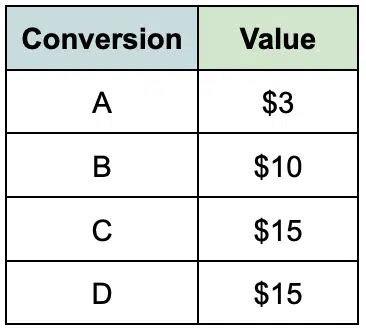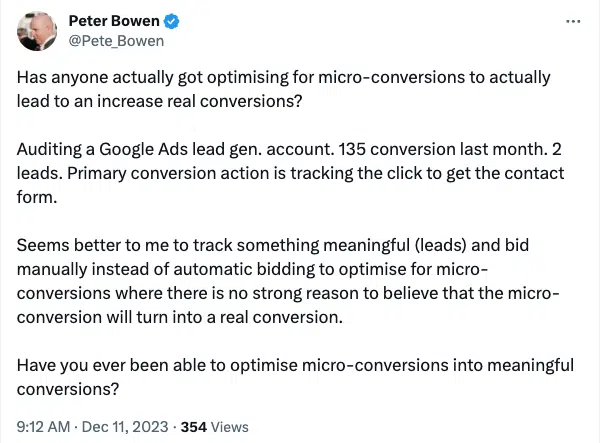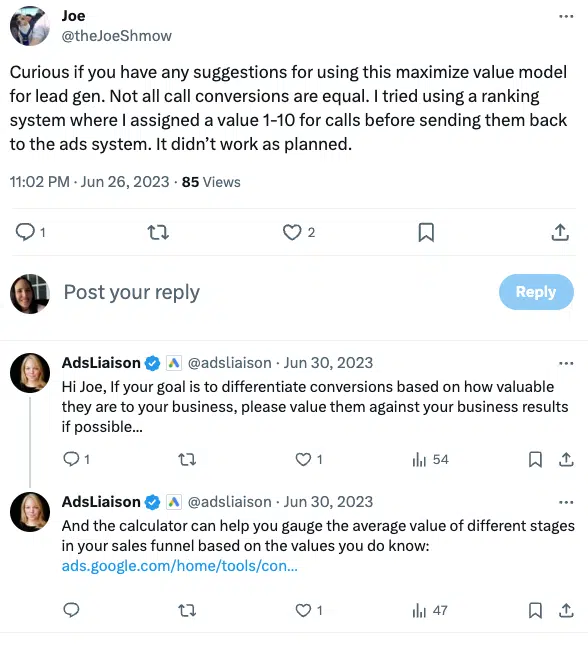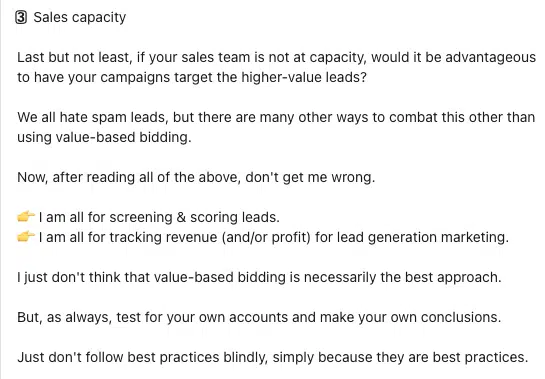Value-based bidding: Why it’s key to boosting your Google Ads
Discover how this bid strategy can optimize your Google Ads campaigns for the most valuable actions and overall profitability.
More advertisers are exploring the potential of value-based bidding (VBB). But what exactly is this method and why does it matter?
This article discusses what you need to know about value-based bidding, how it differs from “Maximize conversions,” and two approaches to implement VBB for your Google Ads account. We’ll also explore perspectives from the PPC community on this evolving strategy.
What is value-based bidding?
Value-based bidding enables you to prioritize conversions differently based on their value to your business. You can assign values to various actions, directing the bidding algorithm to optimize for higher-value outcomes.
This gives you a more nuanced way to bid beyond just chasing conversion volume, aligning your ads with profitability goals.
Questions:
- Which conversion action is preferred: A, B, C, or D?
- If an advertiser has a stronger preference for B over A, then B is assigned a value of $10 and A is assigned a value of $3.
- If the advertiser equally prefers both C and D, but each has more business value than B, then both options can be assigned a value of $15.

These priority values can be attributed to conversions, including actions like:
- Completing a form.
- Watching a video.
- Downloading a white paper.
- Using specific website functionalities such as a chat or quote system.
These lower-value conversions are also called “micro-conversions,” indicating that they are minor actions with business value but are not necessarily the preferred conversion event.
The bidding algorithm, with the provided value data, can now account for the various actions based on the assigned values, with the goal of maximizing the overall generated value from the conversion set.
During auction time, VBB seeks to optimize for the most valuable outcomes as defined by the advertiser and can also function with a tROAS to align with profit goals.
Contrast: The traditional ‘Maximize conversions’ bidding
Traditional maximize conversion bidding, on the other hand, typically revolves around tallying conversions and maximizing volume.
While this approach can be effective, it comes with its drawbacks. Specifically, traditional bidding tends to focus solely on increasing the overall number of conversions without considering the diverse values associated with different conversion actions.
The shortcomings become apparent when considering the intricacies of the buying journey.
Clarifying the value of phone calls and lead forms can be crucial for certain businesses.
Sometimes, phone calls may translate to a higher customer lifetime value or larger orders compared to form submissions.
When a form submission leads to a return call, the call center may encounter difficulties reaching the lead or the lead may simply forget they filled out a form online.
Blocking calls from unknown numbers through spam filtering is another scenario, post form fill.
Maximizing the number of conversions would not consider this additional business knowledge.
The algorithm is known for going after the path of least resistance. If the form is easy and all conversions are treated equally, it is possible to end up with an account optimized primarily for form fills.
This approach might not be ideal for Google’s algorithms either. Merely prioritizing the maximization of conversions may lead to inaccurate data for Google’s machine learning and bidding algorithms.
This is particularly evident in accounts with smaller budgets. Sometimes, advertisers simply cannot afford the preferred conversion. As a result, there is less data available for algorithms to effectively bid.
The traditional way to counter this is to add “easier conversions.” However, these easier conversions are not all equal.
Let’s consider a local venue for parties and weddings as an example. This type of business operates on low margins but has a high price tag associated with a “booked event.” The advertiser might not be able to afford a large budget in Google Ads.
The traditional approach would be to optimize the account for a “booked event.” A single booked event may result in a revenue of $10,000 for a wedding. However, if the monthly advertising budget is only $2,000, optimizing for a “booked wedding event” may not be feasible.
To move forward, you can instead focus on bidding for actions such as “watching a video about the event space” or “downloading a feature sheet” to engage potential customers and continue the sales process.
Based on business knowledge, you know that downloading the feature sheet, which provides the business with an email address, allows you to build a relationship and convert to a “booked wedding event.”
This is where a value-based approach can be applied. By incorporating sales knowledge into the advertising strategy, the business can make informed decisions about which actions will most likely lead to successful conversions and provide the bidding algorithm with enough data based on their budget to bid optimally.
If the scenario above was used indiscriminately, the algorithm would favor the path of least resistance, potentially undermining your true objectives, and the result could be a high number of “video views,” which are not the best path to a “booked event.”
Dig deeper: 5 tips for effective PPC bidding on a budget
The traditional application of value-based bidding
Value-based bidding in Google Ads is standard practice for ecommerce websites. The value of each purchase is passed back into the interface, then the campaigns, ad groups, and keywords can be optimized according to ROI.
The account structure can be configured to allocate a budget based on the products that yield the highest return on investment.
Dig deeper: How non-retail advertisers can embrace value-based bidding in Google Ads
Exception: Value-based bidding for lead generation advertisers
VBB is still not the default implementation in most Google Ads lead gen accounts because it is considered a more advanced approach.
Another factor contributing to the lower adoption rates of VBB is advertisers’ tendency to avoid adding conversions deemed “easier.”
Including browsing-related conversions can artificially inflate conversion numbers and create the illusion of better performance for an account.
Experienced advertising managers prioritize optimizing for the outcome and have operated in this fashion for years.
This exchange on X demonstrates that adding conversions with no discernment can disadvantage the advertiser. The response presents VBB as an approach to managing multiple conversions.


As Melissa Mackey (@beyondthepaid) points out in the thread, VBB is a viable solution. The algorithm will generally focus on higher-value conversions to maximize value.
Approaches to value-based bidding
Two key approaches emerge within value-based bidding, each offering its unique advantages.
Method 1: The ranking values method
This approach entails assigning importance rankings to conversions (1, 2, 3, 4, 5, etc.), directing the algorithm to prioritize higher-ranking actions. However, this method lacks the precision required to accurately represent ROI. The assigned value merely signifies importance.
This method is more sophisticated than the maximize conversion approach. However, the return on advertising spend (ROAS) achieved through this method would hold no significance.
Method 2 (Google’s recommendation): Calculate the true business value for each conversion action
This approach involves attributing actual monetary worth to each conversion, considering factors such as customer lifetime value, profit margin, and sales process knowledge.
Integrating true ROI into the advertising platform provides a more precise evaluation of the campaign’s effectiveness.
This is also the approach Google recommends. Google has created a tool to help calculate the values that can be accessed here.
There was also a thread on X where Google Ads Liaison Ginny Marvin addressed this answer.
In the thread, @theJoeShmow asked about the first method outlined above, and the recommendation is to take the time to calculate the true meaning for your business.

What does the paid search community think?
Michael De Boeck posted on LinkedIn that he doesn’t like value-based bidding because it is positioned as the “ultimate upgrade” for lead generation campaigns.
De Boeck highlights that “value-based strategies are biased to adapt toward higher-value conversions.” He also emphasizes the importance of asking key questions about the sales process when adopting this bidding approach.

Miles McNair on X recommends testing VBB using the experiments, ranking it as his top recommended test.

Lastly, @theJoeShmow on X suggests that VBB could be a method for Google to gather more information from advertisers to assess how much bid thresholds can be raised.

The verdict for value-based bidding
Like most answers in advertising, the answer lies firmly in your data.
Optimizing accounts for “easier conversions” makes sense for advertisers with smaller budgets and limited data. This allows advertisers to realize the benefit of paid advertising without optimizing for the most expensive outcome, which can be quite costly.
Prioritizing the value of conversions over volume enables bidding on desired actions while maximizing overall ROI.
Regularly analyzing data and segmenting actions is essential to make decisions around marketing effectiveness.
In essence, value-based bidding allows advertisers to define and prioritize valuable conversions, applying a target ROAS strategy to achieve their advertising goals.
Success in advertising hinges on advertisers who take the time to analyze data and define the value of actions, while those who neglect this step may face failure.
The crucial factor lies in leveraging business information with the right automated bidding strategies aligned with goals.”
Advertisers who analyze their business and plan strategically will outperform those who set it and forget it in the automated world of Google Ads.
Success comes from a strategic mindset, not just automation. In 2024, VBB stands out as a powerful tool for advertisers aiming for a more advanced and strategic approach.
Dig deeper: How to make PPC automation work for lead gen
Opinions expressed in this article are those of the guest author and not necessarily Search Engine Land. Staff authors are listed here.
Related stories
New on Search Engine Land